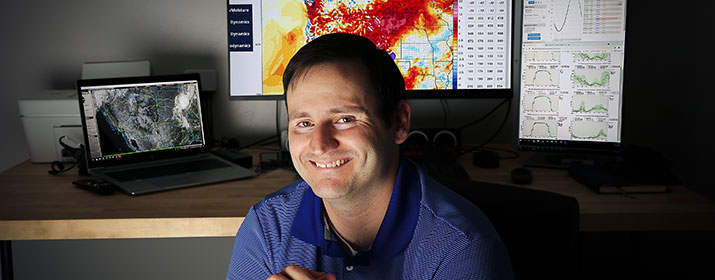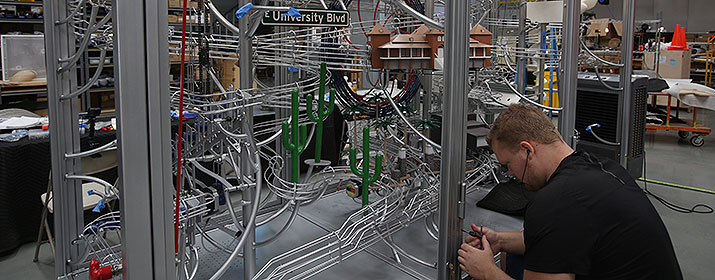
Tucson Electric Power must operate a balanced grid at all times. This means we need to generate, buy and deliver the exact amount of power that customers are using in real time.
There’s a bit of wiggle room, provided mainly by spinning generator turbines that work like shock absorbers to smooth out small imbalances in the grid. But if energy and demand fall too far out of balance, outages occur and can sometimes cascade to affect neighboring systems.
Accurately forecasting energy demand and resources and delivering the right amount of energy is part art and a lot of science. It requires both long- and short-term planning with adjustments along the way. More frequent and extreme weather, adding more wind and solar power to our energy mix, and increased energy demand from electric vehicle charging have all added complexity to our planning.
Think of our forecasting plans and process as a big funnel. The widest part of the funnel represents our Integrated Resource Plan (IRP), which outlines how we plan to satisfy future energy needs. TEP’s 2020 IRP commits that we’ll provide 70 percent of our power from renewable resources and reduce carbon emissions by 80 percent by 2035.
As time passes, the funnel narrows as we develop the resources called for by our IRPs and refine our load forecasts. The data, conditions and analyses change right up to the minute of simultaneous energy generation and use – the point where energy leaves the “funnel.”
Our planners look at historical trends as well as weather patterns to help with their forecasts. Our planning is typically focused on serving higher energy demands in the summer, when usage typically ramps up in the morning, drops significantly during midday and then increases sharply in late afternoon just as solar production is declining.
“We look at historical trends for energy usage on similar days based on morning highs and lows and season. In the summer, those are weighted heavier,” said TEP Business Intelligence Analyst Patrick Lacy. Planning for anticipated demand, means evaluating a combination of other factors, he said, including:
- forecasted temperatures;
- anticipated humidity;
- precipitation; and
- output from wind and solar systems.
Energy resource planners use demand forecasts to help refine the mix of resources we’ll need.
“We always look at the flexibility of energy resources to help us manage our load as well as their costs and impact on climate change,” said TEP Resource Planning and Procurement Manager Victor Aguirre. “We’re also conscious about water usage and the emissions created when making decisions about the type of energy we’ll use to meet demand. Reliability is very important, so increasingly we’re looking at ways to store more of the wind and solar power we generate.”
Our models and forecasts also factor in potential energy savings from TEP’s energy efficiency programs as well as assumptions about local EV market penetration, both of which affect demand.
TEP always uses the cleanest energy first and after that, resource decisions are driven by cost.
“We try to use every megawatt of clean energy that we own first in our resource mix,” Lacy said. “After that, the resources used are based on economics. We always try to use the least expensive energy to meet forecasted demand, even if that means purchasing power on the wholesale market. This helps us keep costs lower for customers.”
Aguirre said having renewables represent a larger share of our resource mix can be challenging at times. If clouds roll in, a storm lingers or winds don’t blow, additional resources may be needed to meet demand.
“Solar and wind energy are still simulated in our models because they can be intermittent but are usually used first. We still need to have other resources available and ready to use given the variability of renewable energy,” he said.
Our energy plans include a 15 percent reserve to help us accommodate unforeseen events, such as a generating unit outage or an extreme weather event. “Climate change has changed how we plan, mostly from a reserves standpoint,” said Lacy. “We need to prepare for more frequent weather events that impact our energy planning to make sure we have enough capacity to handle extreme loads.”
Once energy leaves the planning “funnel,” TEP’s Balancing Authority Operators take over to ensure those resources are well balanced with usage. They monitor the frequency of the local and regional grid and call for changes in generation and system operation if necessary to ensure that they remain stable.
“Our operators are responsible for monitoring our loads, generation and imbalance market participation 24 hours day,” said Lauren Briggs, who managed TEP’s balancing authority before taking a new role as Director of Resource Procurement and Planning. “Through our membership to the Western Energy Imbalance Market (WEIM), we can balance our own load while taking excess renewables from other Balancing Authorities.”
The WEIM is a regional energy market that connects participating utilities to available resources in the region. Excess output is sold in real time in increments as small as five minutes, helping grid operators optimize their portfolio and compensate for the variable output of solar and wind resources.






